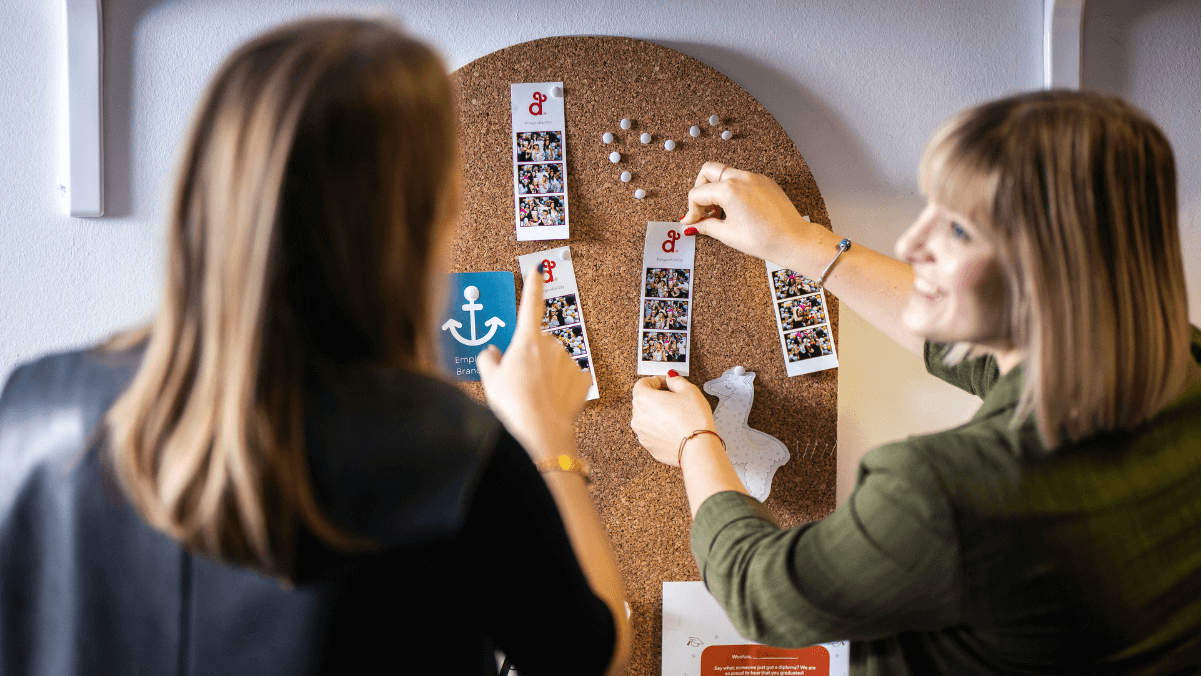Did you know that 70% of people who had exceptional onboarding say that they have “the best possible job”? (Source: Kallidus). On the other hand, a negative onboarding experience doubles the chances of an employee seeking another opportunity.
What is it about onboarding that makes such a difference? We have some tips & tricks up our sleeve, so read on!
What is the employee onboarding process?
Employee onboarding is the process of introducing the new employee to the company’s values, processes, people, and culture. Onboarding starts right after the candidate has accepted an offer and is finished when the person hired is fully familiarized with the company, ready to take charge of their job responsibilities on their own, and feels welcome and comfortable in the company with their new colleagues.
The important thing to remember is that onboarding is a process – it is not just a one-time thing where your new employee gets cool company swag on their first day or watch a quick video demonstrating the company vision, and after that, they are left on their own to find a way to settle in on the new job. Since good talent is hard to find, you shouldn’t leave anything in your onboarding to chance. Also, it is wise to make onboarding a true teamwork experience for everyone included – the new employee’s manager is supposed to have a crucial role in the onboarding process, just like their teammates.
The Back Office Team and IT should also be included, and it is always great if your CEO can meet and greet new people. Another tip – don’t just include all of them, have them aligned because you will create an even more consistent experience for your newcomer. Also, our suggestion is to include and activate all team members to welcome the new person – for example, on company social media channels.
Creating an Onboarding Program
Creating an employee onboarding program is a complex and long-term process. However, it is essential to remember that it represents multiple returns on investment in the long run! A complete employee onboarding process should, besides paperwork and equipment, include social and cultural adjustment.
When creating an employee onboarding program, start by asking what the new employee needs to get to know the company, its values, team, culture, and, of course, all the information necessary to master their work obligations and requirements. Think about what the person needs to feel welcome and to get a sense of that open and comfortable company culture on their very first day!

Sounds like a lot of work? It is, but it is beautiful work!
Why does efficient employee onboarding matter?
Remember your first day at your current company. What were your positive and what were your negative impressions? Think about it in the context of your entire onboarding period. Has anything happened during the process that made you think this is not the company for you?
If you had a negative experience with your onboarding process and an overall bad impression, you were more likely to leave the company! According to onboarding experience statistics, as much as 20% of staff turnover occurs within the first 45 days of employment.
So, what can HR personnel do to ensure the onboarding process is complete and of quality, and why should they do it? Let’s see the benefits of a good onboarding process!
A great onboarding experience can decrease turnover and increase retention. It can also increase employee performance and engagement. That way, the person will fit into the company culture more easily and better understand performance expectations.
The time to exceed proficiency in work will decrease, the manager and team will be satisfied, and the cost for the company will be reduced.

Onboarding process flow
Let’s see which steps make an excellent onboarding! Of course, the timeline is very adaptable to your needs.
- Talking about the offer
When the selection process is finished, and you find the perfect candidate for the role, the first step is making the offer. Everything about the offer has to be transparent and should explain all the benefits (not just pay grade!) in great detail. It should present the job description, requirements, and expectations very clearly.
Of course, the pay for the role should also be transparent – include both gross and net income. Include financial (e.g., gym membership or medical examinations) and non-financial benefits (e.g., dog-friendly office, remote work options, or open-communication culture). Of course, you must be honest – you want the new member to fit into your team. Trying and impress a new colleague can be tempting, but don’t say things that are not true for your company.
We like to make a video call with candidates to go over the offer, and after that, we send the proposal by mail. That way, a person can ask everything that interests them live, on the video call and review the offer in their own time.
- Preparing everything for the new employee
Yay! A perfect candidate has accepted the offer! This is always great news, but wait, don’t get too excited. While waiting for the person to start working, many new things can happen, and in the worst-case scenario, a candidate can change their mind and reject the offer. Let’s see how to avoid that scenario.
First, when a person accepts the offer, announce the good news to the team participating in the onboarding process. Stay in contact with that person – HR should send all the necessary information for the first day, starting from the date and time of arrival. Send the short plan and schedule of the person’s first day, instructions about parking, lunch options, etc., and don’t forget to assign the point of contact if a person has any questions.
Keep the new employee informed and, at the same time, engaged! For example, ask them to send you their short description, which you can present to the rest of the employees on the person’s first day. Of course, you also should collect all the documents needed for employment. Send the person a contract draft so they can see that everything is well-prepared, on time, and following your agreed-upon offer. Also, inform all the team members about the date of a new person’s arrival – for example, via an internal newsletter.
- Cooperating with everyone included in the onboarding process
Before a person comes to their first day, ensure everything is ready in coordination with everyone included in onboarding. Check whether the equipment, contract, and office supplies are prepared for their arrival. Contact the manager and person’s mentor to see if they are ready for onboarding. Make sure the person has a schedule, a clear onboarding track, and goals and expectations for the first few months.
- The Big Day
Keep in mind that the first day is always challenging! Even if a person comes to work for the company of their dreams.
Make sure the person receives a warm welcome and feels comfortable. Send the welcome mail to the person and talk to them about the company, its values, and plans. Share the documents and education programs to help them get to know the company and all its parts! Make sure that a person is well-introduced to all the colleagues, especially to the team they are joining. Show them around the office – it’s more important than you might think so that they know where the restroom, kitchen, etc., are.
- Training and orientation period
In the first 15-30 days, organize and coordinate training to get the person on track. Ensure that the person understands the education programs you shared with them on the first day and that they attend these pieces of training. Those will help with getting to know the departments and management of the company, but also the values, goals, and plans of each department and company as a whole.
The main focus of this period should be getting the bigger picture of the company, understanding the business strategy, internal processes, etc. Of course, this segment of the onboarding process is under HR jurisdiction. Another vital part of onboarding is a detailed introduction to their new job, goals, and how fulfilling those goals is measured and rewarded. This part is introduced by the mentor, manager, and team. Last but not least, it is just as important for the person to bond with teammates in informal surroundings as in formal ones.
- Get to work phase
After that first month, when the person gets acquainted with their job’s requirements, they are expected to start taking over the tasks. However, the person is still settling in, so if we could only give an employer one piece of advice, it would be this: give feedback. Similarly, the most important piece of advice for a new person is to ask questions.
The first month is the most demanding period of the onboarding process. It gets easier after that, the new employee starts to feel more comfortable, and their work ownership gradually increases.
However, we are not done yet. New employee did start to work on their assignments, but they still need to get acquainted with many other things, among which is one of the most important information – how success is measured and rewarded in the company. Here, the person’s manager and HR play a role. Now would also be a good time to meet the stakeholders if that is necessary for their position. All this time, it is important to teach the new employee company values on the operational level (E.g., how to communicate with the client, how often, in what way, how to ensure quality services, etc.) – these small pieces of information are often overlooked, but are of great importance for the image of the company and great value for the quick onboarding of new employees.
- The first 90 days and evaluating the employee’s onboarding experience afterward
It is often said that after three months, most onboarding processes come to an end. Whether your onboarding was that long or whatever length you found was suitable for your company’s purposes, make sure that all that time, newcomers (and all the employees) know that HR is always available to them for any questions. Check in with the newcomer regularly and see if they are satisfied and feel comfortable in the company.

In the end, prepare a structured, official evaluation of the onboarding experience and ask your new colleague to complete the survey after the onboarding period. They have just gone through the process and can witness what was helpful and what was not. That way, you can detect both benefits and areas of improvement in your onboarding process.
In addition, you can have a welcome interview with the person after a few months to gather additional feedback. The team can also prepare a mini-celebration after the onboarding and probation period!
The more evaluations you receive, the better your reports about onboarding will be, which will help you optimize it.
P.S. No matter what they tell you, don’t get carried away – onboarding can be informal and fun, full of fluffy stuff and social moments with buddies and mentors, but it also needs structure to serve its purpose.
Conclusion
Onboarding is a complex process that includes many steps and engages many people! It can be a true teamwork experience, and it is immensely important for the new employee to get a sense of the company’s culture and values, as well as job requirements and company expectations. A great onboarding experience can positively impact the new person and team and, finally, bring great long-term results for the company!




